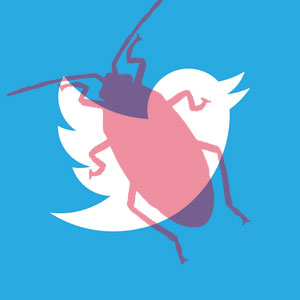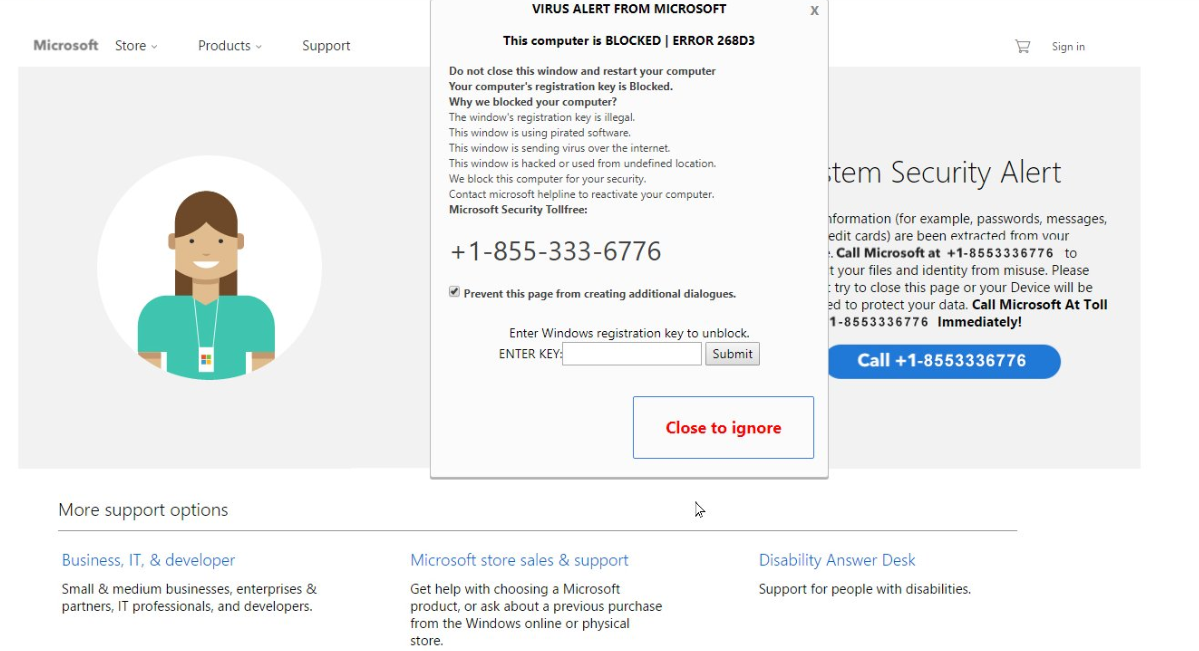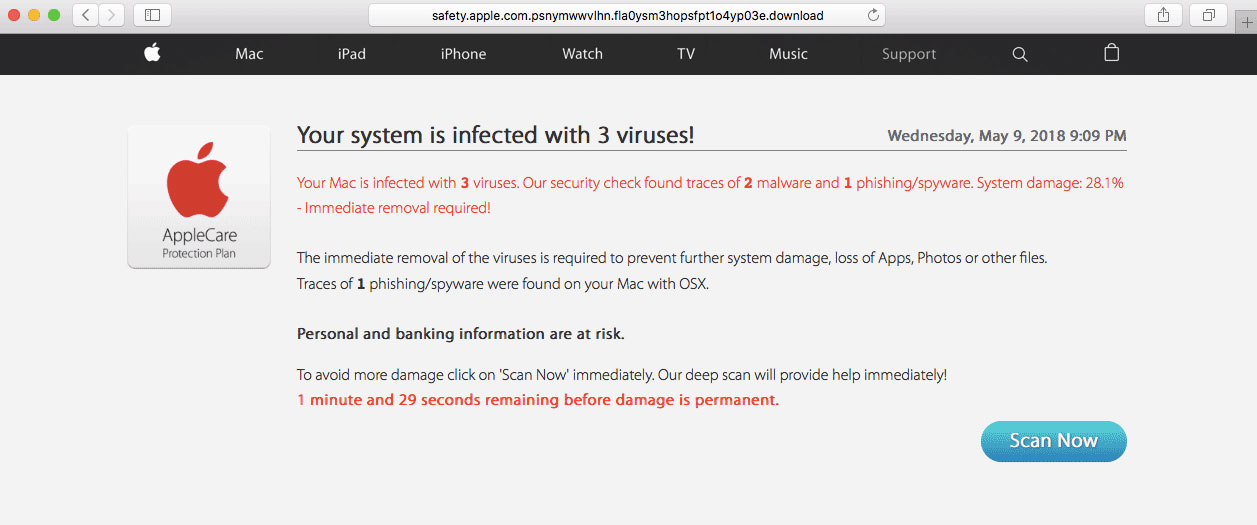This blog post has been made in order to explain to you how you can detect viruses on Twitter and how to remove these viruses in case you have identified them.
Dangerous viruses have always been spreading on Twitter, but lately, they have started to become more dangerous. Most viruses on Twitter tend to spread at an alarming rate via web links posted on Tweets that offer discounts, coupons or even programs that claim to show you who has visited your Twitter profile.
The bad news is that clicking on those web links may bring adware, spyware or ransomware on your computer and the impact of that is only negative for you. In this article we will go over some of the biggest twitter viruses out there and we will show you how you can remove a Twitter virus from your computer, plus how you can protect yourself from these infections.

Threat Summary
| Name | Twitter Virus |
| Type | Twitter-related Malware |
| Short Description | May infect you with different types of viruses, ranging from adware to spyware and data stealers. |
| Symptoms | Depends on the virus infecting you. If adware, you will see ads, if ransomware, your files may eb encrypted, if Trojan, you may see suspicious behavior. |
| Distribution Method | Via tweets with malicious web links. |
| Detection Tool |
See If Your System Has Been Affected by malware
Download
Malware Removal Tool
|

Twitter Viruses – Distribution Methods
There is one main distribution method that characterizes all Twitter viruses and that is via twets containing malicious web links embedded within them. These types of tweets could either be public or may come as messages sent directly to users. Some of those private messages and tweets can be seen below:
Have you heard Google was hiring people to work from home? Pretty cool I thought {malicous web link}
Sign in and download this fantastic app – only available today: {Malicious link}
I just viewed my TOP20 Profile STALKERS. I can’t believe my EX is still checking me every day: {malicious link}
WOW! You can see WHO VISITS your TWITTER profile. That’scool! – {malicious link}
Message: David Video {malicious link}
The most often used web links to spread viruses could turn out to be random URLs and also shortened URLs, like:
- Bit.ly web links.
- Vid.me web links.
- TinyURL sites.
- Adf.ly
- Tiny.cc
- Is.gd
- Soo.gd
- S2r.co
- Clicky.me
- Budurl.com
These sites are for shortening URLs, which In general are not risky, but cyber-criminals often use them to slither multiple different types of viruses via malicious web links by adding JavaScript and making the web links with automated download (drive-by downloads).

Twitter Viruses – Types and Analysis
There are several threats that can be presented to victims as a result of clicking on Twitter Virus web links ranging from less dangerous to outright evil. Below we have explained each type of virus, which could have infected you if you have clicked on this URL.
Phishing Sites
Surveys, fake retailer sites, fake Twitter login pages, all of those belong to the phishing kind. One of those viruses that is extremely spread at the moment advertises web links to fake retailer sites, where it likely wants you to type in your information in order to buy a product on a discount. The main brands advertised by this phishing scam so far are:
- Ray-Ban.
- Nike.
- UGG.
In addition to fake online retailer sites, that aim to steal your financial credentials, the links may also ask you to log in Twitter, Facebook, Google or other accounts under the pretext that you may have been logged out. These fake pages very well imitate the original login pages. One such scam was the Twitter Phishing campaign we have detected a while back.
Another type of phishing scam which is going around all over the web and may also be seen on Twitter is the scam that poses as if the user has won a Gift Card. The most famous of those scams was the $1000 Amazon Gift Card scam which aimed to ask victims for a lot of their personal infromation and currently (at the time of writing this), there is another version of this scam advertising fake Wal-Mart gift cards.
In order to learn how to protect yourself from phishing sites, we recommend reading the guide below:
How to Detect and Remove Phishing (Fake) Web Pages
Malicious Web Links
The other main threat that is related to malicious links on Twitter is malware infection. Such web links can lead you to redirect pages that automatically lead you to sites that have malicious JavaScript or other forms of scrips enabled and these sites may automtically download and execute a malware file directly on your computer system. This is known in the trade as a drive-by download and as a result of it, you may become infected with a variety of malware types:
- Coin miner virus.
- Various Trojan types and RATs.
- Rootkits.
- Botnets.
One of the main threats in relation to malware spreading on Twitter which we have seen is the gigantic botnet operation on Twitter which was first discovered on April 17th. The botnet managed to infect by using over 3 million fake accounts on Twitter and 100,000 bots spreading web links. The accounts reportedly made 2.6 billion tweets with malicious web links, infecting with all sorts of malware.
Tech Support Scam Sites
These forms of scams are very well known already, but that does not seem to prevent them from spreading across all types of computers. The way they work is when you click on a Twitter link, you may become redirected to a web page that claims that your PC or Mac is damaged, like in the images we have shown below.
The outcome of these pages is to convince you, the user to call a fake tech support number, where you are likely asked to either give access to the scammers who pretend to be a Microsoft or Apple tech support people, but in fact are the scammers. And to fix the “issue” which the scam page strives to decieve you in believing is real, the scammers want hundreds of dollars to be paid. If you see such pages, do not call the numbers under no circumstances.

Remove Twitter Viruses from Your Machine
In order to remove a Twitter virus, you will firstly need to backup your important files, just in case they may be at risk. Then, we recommend you to follow the removal instructions that are underneath this article. They have been made with the idea to help you identify the source of the viruses that may be attacking your computer and remove them thoroughly. If manual removal does not seem to help, we recommend what most experts would advise you to do and that is to download and run a scan by using an advanced anti-malware software. Such program will help you to remove all of the related files to the Twitter virus automatically and will also help protect your computer system against any infections that might occur in the future as well.
Preparation before removing Twitter Virus.
Before starting the actual removal process, we recommend that you do the following preparation steps.
- Make sure you have these instructions always open and in front of your eyes.
- Do a backup of all of your files, even if they could be damaged. You should back up your data with a cloud backup solution and insure your files against any type of loss, even from the most severe threats.
- Be patient as this could take a while.
- Scan for Malware
- Fix Registries
- Remove Virus Files
Step 1: Scan for Twitter Virus with SpyHunter Anti-Malware Tool



Step 2: Clean any registries, created by Twitter Virus on your computer.
The usually targeted registries of Windows machines are the following:
- HKEY_LOCAL_MACHINE\Software\Microsoft\Windows\CurrentVersion\Run
- HKEY_CURRENT_USER\Software\Microsoft\Windows\CurrentVersion\Run
- HKEY_LOCAL_MACHINE\Software\Microsoft\Windows\CurrentVersion\RunOnce
- HKEY_CURRENT_USER\Software\Microsoft\Windows\CurrentVersion\RunOnce
You can access them by opening the Windows registry editor and deleting any values, created by Twitter Virus there. This can happen by following the steps underneath:


 Tip: To find a virus-created value, you can right-click on it and click "Modify" to see which file it is set to run. If this is the virus file location, remove the value.
Tip: To find a virus-created value, you can right-click on it and click "Modify" to see which file it is set to run. If this is the virus file location, remove the value.Step 3: Find virus files created by Twitter Virus on your PC.
1.For Windows 8, 8.1 and 10.
For Newer Windows Operating Systems
1: On your keyboard press + R and write explorer.exe in the Run text box and then click on the Ok button.

2: Click on your PC from the quick access bar. This is usually an icon with a monitor and its name is either “My Computer”, “My PC” or “This PC” or whatever you have named it.

3: Navigate to the search box in the top-right of your PC's screen and type “fileextension:” and after which type the file extension. If you are looking for malicious executables, an example may be "fileextension:exe". After doing that, leave a space and type the file name you believe the malware has created. Here is how it may appear if your file has been found:

N.B. We recommend to wait for the green loading bar in the navigation box to fill up in case the PC is looking for the file and hasn't found it yet.
2.For Windows XP, Vista, and 7.
For Older Windows Operating Systems
In older Windows OS's the conventional approach should be the effective one:
1: Click on the Start Menu icon (usually on your bottom-left) and then choose the Search preference.

2: After the search window appears, choose More Advanced Options from the search assistant box. Another way is by clicking on All Files and Folders.

3: After that type the name of the file you are looking for and click on the Search button. This might take some time after which results will appear. If you have found the malicious file, you may copy or open its location by right-clicking on it.
Now you should be able to discover any file on Windows as long as it is on your hard drive and is not concealed via special software.
Twitter Virus FAQ
What Does Twitter Virus Trojan Do?
The Twitter Virus Trojan is a malicious computer program designed to disrupt, damage, or gain unauthorized access to a computer system. It can be used to steal sensitive data, gain control over a system, or launch other malicious activities.
Can Trojans Steal Passwords?
Yes, Trojans, like Twitter Virus, can steal passwords. These malicious programs are designed to gain access to a user's computer, spy on victims and steal sensitive information such as banking details and passwords.
Can Twitter Virus Trojan Hide Itself?
Yes, it can. A Trojan can use various techniques to mask itself, including rootkits, encryption, and obfuscation, to hide from security scanners and evade detection.
Can a Trojan be Removed by Factory Reset?
Yes, a Trojan can be removed by factory resetting your device. This is because it will restore the device to its original state, eliminating any malicious software that may have been installed. Bear in mind that there are more sophisticated Trojans that leave backdoors and reinfect even after a factory reset.
Can Twitter Virus Trojan Infect WiFi?
Yes, it is possible for a Trojan to infect WiFi networks. When a user connects to the infected network, the Trojan can spread to other connected devices and can access sensitive information on the network.
Can Trojans Be Deleted?
Yes, Trojans can be deleted. This is typically done by running a powerful anti-virus or anti-malware program that is designed to detect and remove malicious files. In some cases, manual deletion of the Trojan may also be necessary.
Can Trojans Steal Files?
Yes, Trojans can steal files if they are installed on a computer. This is done by allowing the malware author or user to gain access to the computer and then steal the files stored on it.
Which Anti-Malware Can Remove Trojans?
Anti-malware programs such as SpyHunter are capable of scanning for and removing Trojans from your computer. It is important to keep your anti-malware up to date and regularly scan your system for any malicious software.
Can Trojans Infect USB?
Yes, Trojans can infect USB devices. USB Trojans typically spread through malicious files downloaded from the internet or shared via email, allowing the hacker to gain access to a user's confidential data.
About the Twitter Virus Research
The content we publish on SensorsTechForum.com, this Twitter Virus how-to removal guide included, is the outcome of extensive research, hard work and our team’s devotion to help you remove the specific trojan problem.
How did we conduct the research on Twitter Virus?
Please note that our research is based on an independent investigation. We are in contact with independent security researchers, thanks to which we receive daily updates on the latest malware definitions, including the various types of trojans (backdoor, downloader, infostealer, ransom, etc.)
Furthermore, the research behind the Twitter Virus threat is backed with VirusTotal.
To better understand the threat posed by trojans, please refer to the following articles which provide knowledgeable details.





